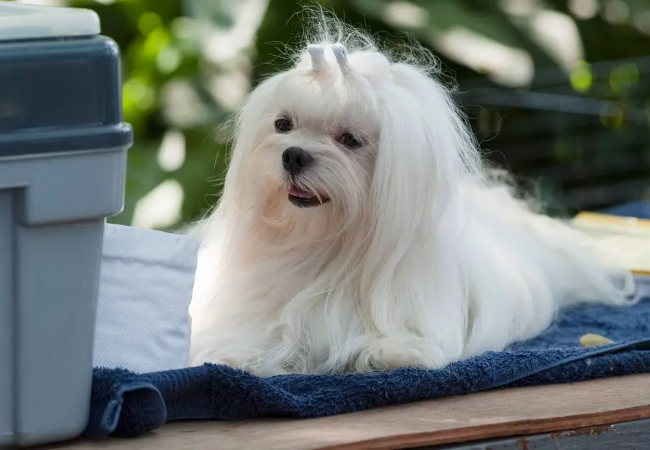Maltese 2025: Luxurious Toy Companion Health & Grooming 🐶✨

In this article
Maltese 2025: Luxurious Toy Companion Health & Grooming 🐶✨
By Dr. Duncan Houston BVSc
Introduction 🌟
The Maltese is an ancient, elegant toy breed cherished for centuries as a royal lapdog and beloved companion. Known for its silky white coat and gentle demeanor, this breed thrives in loving homes and adapts well to apartment life. In this 2025 guide, discover everything you need to know—from history and temperament to grooming, health, training, and ideal family fit.
1. Origins & History 📜
- The Maltese is among the oldest toy breeds, originating around 2,000–3,000 years ago—possibly traced to Malta or Italy, and revered in Ancient Greek and Roman civilizations.
- Documents from Aristotle and Aelian reference miniature white dogs resembling today’s Maltese.
- In the 17th–18th centuries, the breed nearly vanished due to efforts to reduce their size; revival followed through crosses with toy poodles and spaniels by the 19th century.
- Today, they’re recognized by AKC and praised for elegance and affectionate nature.
2. Appearance & Coat 🧥
- Height: ~8–10 in; Weight: 3–7 lb.
- Coat: Straight, silky, pure white (sometimes ivory). It grows long but sheds minimally due to a lack of an undercoat.
- Distinctive features: dark, round eyes; pendulous ears; plumed tail carried over the back.
3. Temperament & Personality ❤️
- Friendly, lively, affectionate, and intelligent; ideal for families and seniors.
- As toy dogs, they are fragile—best in homes with older children or adults.
- They enjoy company and can develop separation anxiety if left alone too often.
- Bark-alert but not excessive; responds well to reward-based training.
4. Grooming & Coat Care ✂️
- Brushing and combing daily to prevent mats and keep the coat silky.
- Bath weekly or biweekly; use mild shampoos and fully dry to avoid skin issues.
- Facial cleaning daily to avoid tear stains; trim around eyes.
- Ear checks weekly, nail trims monthly, dental brushing 2–3× per week due to plaque risk.
5. Exercise & Enrichment 🧠
- Short daily walks (~20–30 min) and indoor play suffice due to small size.
- Interactive toys and gentle trick training provide mental stimulation.
- A secure, calm environment suits their petite stature and sensitivity.
6. Health & Lifespan 🩺
- Lifespan averages 12–15 years; some dogs reach 18+ years.
- Common health issues:
- Dental disease due to a small jaw and plaque buildup.
- Luxating patella (dislocating kneecap).
- Eye problems: cataracts, progressive retinal atrophy.
- Collapsed trachea, hypoglycemia, and liver shunts are occasionally observed.
- Preventive care: annual vet visits, dental cleanings, patella and eye screenings, and weight monitoring.
7. Nutrition & Feeding 🍽️
- High‑quality small‑breed food supports metabolism and dental health.
- Measured portions: 2–3 meals/day to prevent hypoglycaemia.
- Provide dental chews and consider omega‑3 supplements for coat and joint support.
8. Training & Socialization 🎓
- Respond well to positive reinforcement—short, fun sessions are ideal.
- Early socialization with varied people, pets, and sounds builds confidence.
- Crate training supports potty routines and separation anxiety.
- Consistency and patience help manage gentle but willful personalities.
9. Family Fit & Lifestyle 🏡
- Ideal for singles, couples, seniors, or families with older children.
- Great in apartments—requires minimal space but plenty of attention.
- Fragile—supervision needed around toddlers or large pets.
- Moderate barkers—training helps control nuisance noise.
10. Adoption vs. Buying 🌟
- Consider Maltese rescues or shelter dogs—many need loving homes.
- If buying, choose reputable breeders with health screenings (patella, dental, eyes).
- Typical puppy price: $600–2,000 depending on lineage and location.
11. FAQs ❓
- Do they shed? Almost not—minimal shedding but require daily grooming.
- Are they good with kids? Best with gentle older kids—not suited for toddlers.
- Do they bark a lot? Can be alert barkers; training helps manage it.
- Are they hypoallergenic? Often labeled so—low shedding but not allergen‑free.
12. Ask A Vet, 🐾
- Ask A Vet: Get expert advice on dental hygiene, respiratory issues, patella concerns, or coat care.
13. Final Thoughts ✅
The Maltese is a charming, gentle, and long-living toy companion—perfect for households that cherish elegance, close companionship, and dedicated grooming routines. With mindful training and proactive health care, they bring years of love and grace. For expert guidance anytime, visit AskAVet.com and download the Ask A Vet app—your partner in lifelong Maltese wellness!






